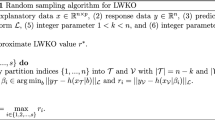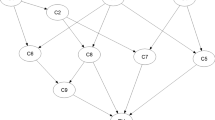Abstract
Research on data valuation using Shapley value has recently garnered significant attention. Existing approaches typically estimate the value of the training set by using the model’s performance on a validation set as a utility function. However, since the validation set is often a small subset of the complete dataset, a dataset shift between the training and validation sets may lead to biased data valuation. To address this issue, this paper proposes a k-fold cross-validation method based on the Shapley value. Specifically, the dataset is divided into k subsets, and each subset is employed in turn as a validation set to evaluate the valuation of the training set composed of the remaining \(k-1\) subsets by using the Shapley value. The average of \(k-1\) valuations of each data instance is taken as the valuation result. Given the exponential correlation between the Shapley value’s computation overhead and the volume of data, we propose the Monte Carlo permutation, incremental learning, and batch data valuation methodologies. This approach aids in approximating the true Shapley value as precisely as possible while simultaneously reducing computation time. Extensive experiments have demonstrated the effectiveness of our method, especially in the presence of noise and outliers in the validation set.
Access this chapter
Tax calculation will be finalised at checkout
Purchases are for personal use only
Similar content being viewed by others
References
Wang, W., et al.: Internimage: Exploring large-scale vision foundation models with deformable convolutions. arXiv preprint arXiv:2211.05778 (2022)
Liu, Z., et al.: Swin transformer v2: Scaling up capacity and resolution. In: Proceedings of the IEEE/CVF Conference on Computer Vision and Pattern Recognition, pp. 12009–12019 (2022)
Varshni, D., Thakral, K., Agarwal, L., Nijhawan, R., Mittal, A.: Pneumonia detection using CNN based feature extraction. In: 2019 IEEE International Conference on Electrical, Computer and Communication Technologies (ICECCT), pp. 1–7. IEEE (2019)
Chrysos, G.G., Moschoglou, S., Bouritsas, G., Panagakis, Y., Deng, J., Zafeiriou, S.: P-nets: Deep polynomial neural networks. In: Proceedings of the IEEE/CVF Conference on Computer Vision and Pattern Recognition, pp. 7325–7335 (2020)
Sun, K., Xiao, B., Liu, D., Wang, J.: Deep high-resolution representation learning for human pose estimation. In: Proceedings of the IEEE/CVF Conference on Computer Vision and Pattern Recognition, pp. 5693–5703 (2019)
Russakovsky, O., et al.: Imagenet large scale visual recognition challenge. Int. J. Comput. Vision 115, 211–252 (2015)
Winter, E.: The shapley value. In: Handbook of game theory with economic applications, 3, pp. 2025–2054 (2002)
Quinonero-Candela, J., Sugiyama, M., Schwaighofer, A., Lawrence, N.D., (Eds.).: Dataset shift in machine learning. In: Mit Press (2008)
Park, C., Awadalla, A., Kohno, T., Patel, S.: Reliable and trustworthy machine learning for health using dataset shift detection. Adv. Neural Inform. Process. Syst. 34, 3043–3056 (2021)
Jia, R., et al.: Towards efficient data valuation based on the shapley value. In: The 22nd International Conference on Artificial Intelligence and Statistics, pp. 1167–1176. PMLR (2019)
Ghorbani, A., Zou, J.: Data shapley: Equitable valuation of data for machine learning. In: International Conference on Machine Learning, pp. 2242–2251. PMLR (2019)
Tang, S., et al.: Data valuation for medical imaging using Shapley value and application to a large-scale chest X-ray dataset. Sci. Reports 11(1), 1–9 (2021)
Sun, X., Liu, Y., Li, J., Zhu, J., Liu, X., Chen, H.: Using cooperative game theory to optimize the feature selection problem. Neurocomputing 97, 86–93 (2012)
Koh, P.W., Liang, P.: Understanding black-box predictions via influence functions. In: International Conference on Machine Learning, pp. 1885–1894. PMLR (2017)
Liu, Z., Chen, Y., Yu, H., Liu, Y., Cui, L.: Gtg-shapley: Efficient and accurate participant contribution evaluation in federated learning. ACM Trans. Intell. Syst. Technol. (TIST), 13(4), 1–21 (2022)
Song, T., Tong, Y., Wei, S.: Profit allocation for federated learning. In: 2019 IEEE International Conference on Big Data (Big Data), pp. 2577–2586. IEEE (2019)
Chen, J., Song, L., Wainwright, M.J., Jordan, M.I.: L-shapley and c-shapley: Efficient model interpretation for structured data. arXiv preprint arXiv:1808.02610 (2018)
Ancona, M., Oztireli, C., Gross, M.: Explaining deep neural networks with a polynomial time algorithm for shapley value approximation. In: International Conference on Machine Learning, pp. 272–281. PMLR (2019)
Sharchilev, B., Ustinovskiy, Y., Serdyukov, P., Rijke, M.: Finding influential training samples for gradient boosted decision trees. In: International Conference on Machine Learning, pp. 4577–4585. PMLR (2018)
Cook, R.D.: Detection of influential observation in linear regression. Technometrics 42(1), 65–68 (2000)
Dasgupta, A., Drineas, P., Harb, B., Kumar, R., Mahoney, M.W.: Sampling algorithms and coresets for _p regression. SIAM J. Comput. 38(5), 2060–2078 (2009)
Kwon, Y., Rivas, M.A., Zou, J.: Efficient computation and analysis of distributional shapley values. In: International Conference on Artificial Intelligence and Statistics, pp. 793–801. PMLR (2021)
Castro, J., Gómez, D., Tejada, J.: Polynomial calculation of the Shapley value based on sampling. Comput. Oper. Res. 36(5), 1726–1730 (2009)
Maleki, S., Tran-Thanh, L., Hines, G., Rahwan, T., Rogers, A.: Bounding the estimation error of sampling-based Shapley value approximation. arXiv preprint arXiv:1306.4265 (2013)
He, K., Zhang, X., Ren, S., Sun, J.: Deep residual learning for image recognition. In: Proceedings of the IEEE Conference on Computer Vision and Pattern Recognition, pp. 770–778 (2016)
Wang, L., Lin, Z.Q., Wong, A.: Covid-net: A tailored deep convolutional neural network design for detection of Covid-19 cases from chest x-ray images. Sci. Reports 10(1), 1–12 (2020)
Islam, M.N., Hasan, M., Hossain, M.K., Alam, M.G.R., Uddin, M., Soylu, A.: Vision transformer and explainable transfer learning models for auto detection of kidney cyst, stone and tumor from CT-radiography. Sci. Reports 12(1), 11440 (2022)
Krizhevsky, A., Hinton, G.: Learning multiple layers of features from tiny images. 7 (2009)
Joulin, A., Grave, E., Bojanowski, P., Douze, M., Jégou, H., Mikolov, T.: Fasttext. zip: Compressing text classification models. arXiv preprint arXiv:1612.03651 (2016)
Acknowledgement
This paper is supported by the National Natural Science Foundation of China (Grant No. 62192783, U1811462), the Collaborative Innovation Center of Novel Software Technology and Industrialization at Nanjing University.
Author information
Authors and Affiliations
Corresponding author
Editor information
Editors and Affiliations
Rights and permissions
Copyright information
© 2023 The Author(s), under exclusive license to Springer Nature Switzerland AG
About this paper
Cite this paper
He, Q., Zhang, M., Zhang, J., Yang, S., Wang, C. (2023). K-Fold Cross-Valuation for Machine Learning Using Shapley Value. In: Iliadis, L., Papaleonidas, A., Angelov, P., Jayne, C. (eds) Artificial Neural Networks and Machine Learning – ICANN 2023. ICANN 2023. Lecture Notes in Computer Science, vol 14256. Springer, Cham. https://doi.org/10.1007/978-3-031-44213-1_5
Download citation
DOI: https://doi.org/10.1007/978-3-031-44213-1_5
Published:
Publisher Name: Springer, Cham
Print ISBN: 978-3-031-44212-4
Online ISBN: 978-3-031-44213-1
eBook Packages: Computer ScienceComputer Science (R0)




